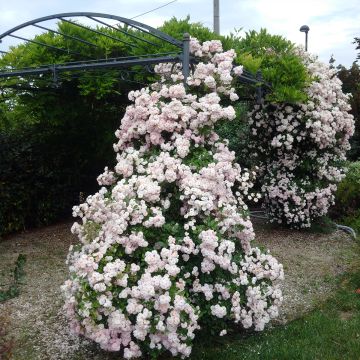
Taking Rose Cuttings: When and How?
Easily Multiply Your Favourite Roses
Contents
Recreating a variety found in an old garden, rejuvenating your plantings, propagating your favourite rose bushes, or preserving heritage roses that have become unavailable commercially are all excellent reasons to try your hand at the joys of taking cuttings. Rooting a rose cutting can be more or less straightforward, depending on the chosen variety and the gardener’s skills.
Only amateur gardeners resort to propagating roses from cuttings. Professionals prefer grafting, as this technique is quicker and produces rose bushes with more uniform growth.
From a rose cutting, it takes three to four years to obtain a plant of decent size. This technique increases the longevity of roses because they aren’t at risk of being overtaken by a rootstock whose vigour exceeds their own. As for the criticism that cuttings produce less vigorous plants, this isn’t always the case. Some varieties perform very well when propagated this way, while others, conversely, need the vigour of a rootstock to thrive.
Some gardeners root their rose cuttings in potatoes, water bottles or Tetra Pak-style packaging, in newspaper and cellophane, with or without rooting hormone, in pots or directly in the ground… It’s up to each gardener to experiment and find the technique that works best for them. However, note that you cannot root a rose cutting in water!
There are several techniques for taking rose cuttings: hardwood cuttings, softwood cuttings, and semi-hardwood cuttings (or semi-ripe cuttings). The latter method offers the highest chance of success, and we recommend following this guide to achieve the best results.
When to take rose cuttings?
Semi-hardwood cuttings of roses are taken during the summer from August through to September.
How to take rose cuttings?
The simplest method is to select a freshly flowered stem, about the diameter of a pencil, and cut it just below a leaf.
- Equip yourself with protective gloves and secateurs. Remove the head of your cutting by making a diagonal cut just above a bud (at the base of a leaf). Then, trim the lower end with a straight cut just below a bud, leaving only a 15 to 20 cm section with three to four leaves.

Straight and diagonal cuts on a rose cutting.
- Prepare the cutting by removing all leaves except the top one.
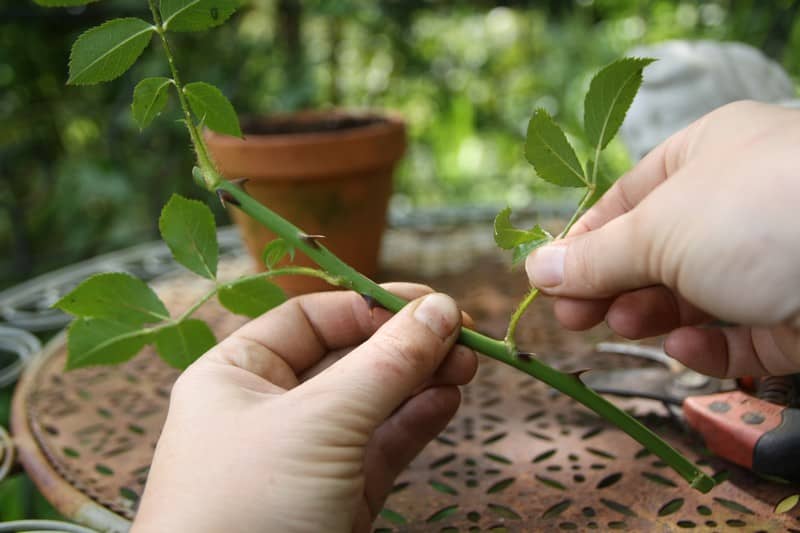
Preparing a rose cutting.
- To reduce evaporation, keep only two to four leaflets (a rose leaf typically has three, five, or seven leaflets) on the remaining leaf.

Leave only a few leaflets on your rose cutting.
- Remove the thorns, as they can create small wounds where roots may develop.
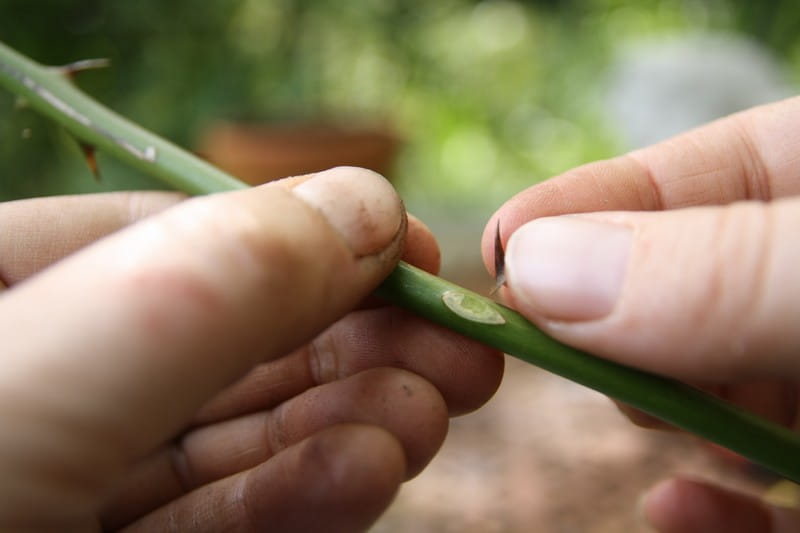
Removing thorns from a rose cutting.
- Prepare several cuttings, wrap them in damp newspaper, and place them in the bottom of the fridge for two or three days to slow sap flow.
- After this time, dip the base of each cutting in some rooting hormone. Tap off any excess powder.
- If you have many cuttings, plant them in a trench in open ground in a well-ventilated, moist, and shaded spot. Alternatively, group them in a pot filled with an equal mix of porous compost and sand. Use a stick to make a hole in the substrate and insert the cutting. Ensure cuttings are planted the right way up—the diagonal cut should be at the top.

Planting a rose cutting.
- Firm the substrate around the cuttings to ensure good contact.
- Water well. In hot weather, place some moss between cuttings to keep them cool. If potted, keep them in a shaded area.
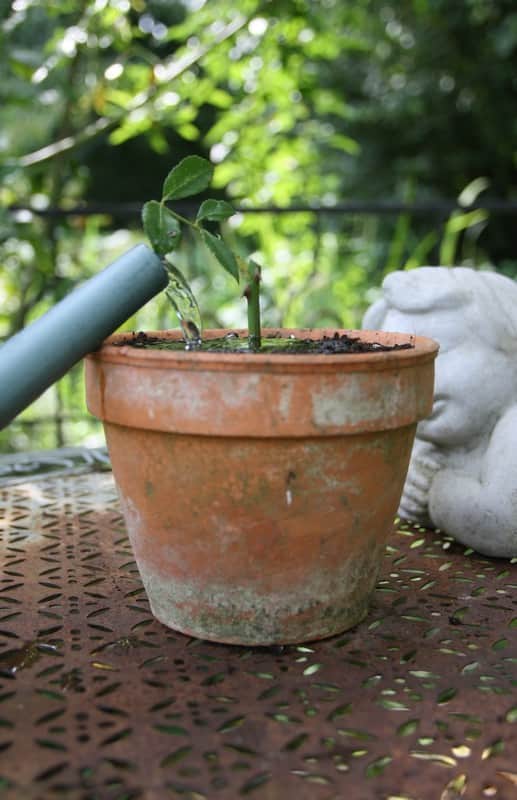
Firm and water your rose cutting before placing it in a shaded spot.
- During winter, protect them from frost by placing them under a cold frame or a layer of dry leaves, ensuring good ventilation.
- In spring, transplant the cuttings into individual pots.
- Once the root ball is well-formed, they can be planted in open ground.
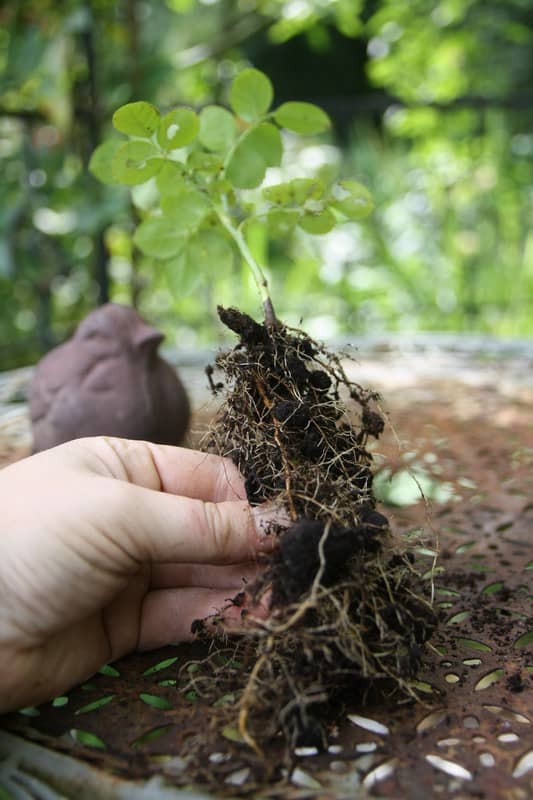
Well-rooted rose cutting.
Note that cuttings taken during the summer flowering lull, in July-August, often root quite easily.
Not all rose species and varieties root with equal ease. Generally, Tea, Noisette, Bengal, Polyantha, Bourbon, Wichuraiana roses and their hybrids root well. Portland roses, however, are more challenging.
Remember that most rose varieties are protected by plant breeders’ rights. Developing a new rose is a lengthy process that deserves respect. Propagation is only permitted for strictly private use.
Discover other Roses
View all →Available in 1 sizes
Available in 1 sizes
Available in 1 sizes
Available in 1 sizes
Available in 1 sizes
Available in 1 sizes
Available in 1 sizes
Available in 1 sizes
Available in 1 sizes
Available in 3 sizes
All you need to know about plant propagation
Discover our advice sheet: “Plant Propagation: Everything You Need to Know About Different Techniques and Our Tips for Successful Cuttings”
- Subscribe!
- Contents








































